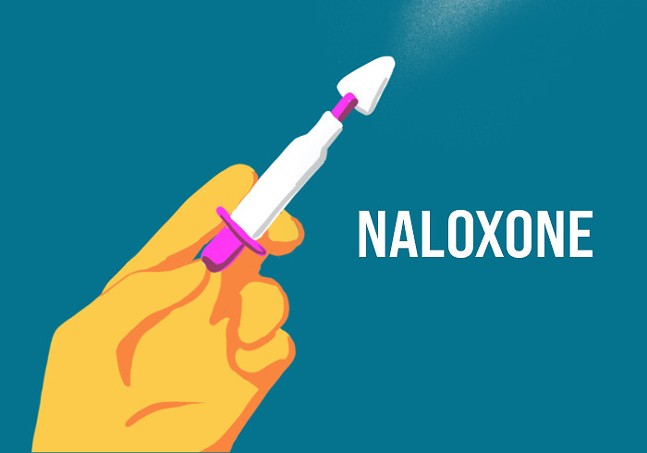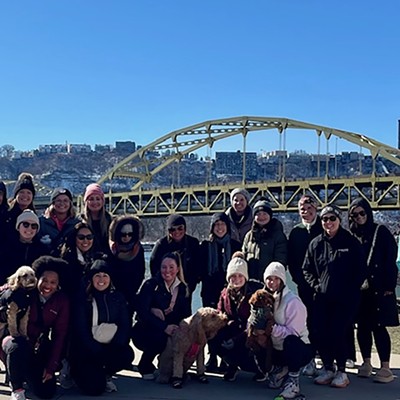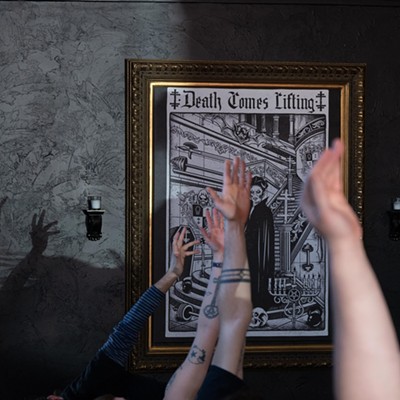Prevention Point questions Pennsylvania's recent increase in higher-dose naloxone access
Last month, Pennsylvania Physician General Dr. Denise Johnson expanded the state’s standing order prescription for naloxone nasal spray to include a nasal spray with a higher dose of the opioid antagonist. While a March 23 press release from the Wolf Administration frames the move as an “expansion'' of the state’s naloxone provision to prevent fatal opioid overdoses, the overdose prevention experts at Prevention Point Pittsburgh question whether this is the most effective move to increase access to the life-saving drug.
“We at Prevention Point started giving out naloxone in 2005,” Alice Bell, an overdose prevention specialist at Prevent Point Pittsburgh, a harm-reduction organization that runs several syringe exchange sites in the city, tells Pittsburgh City Paper. “We actually had prescribers who came to the syringe service program every week and wrote out individual prescriptions for each person that got naloxone.”
Naloxone is a medication approved by the U.S. Food & Drug Administration to rapidly reverse an opioid overdose by quickly restoring breathing to a person if their breathing has slowed or stopped because of an opioid overdose. Naloxone can be administered by individuals with or without medical training to help reduce opioid overdose deaths.
Theoretically, Bell says, Pennsylvania’s statewide standing order for naloxone spray, which allows Pa. residents to print a prescription online and take it to a pharmacy to buy naloxone, is intended to make obtaining naloxone as easy as getting a flu shot.
“If you go to a pharmacy and get a flu shot, you don't have to get an individual prescription from your doctor, there's a blanket prescription, a standing order prescription,” Bell says.
Unfortunately, Bell doesn’t see a need for Pa.’s move to add an 8-milligram dose of naloxone nasal spray, previously available in 2- and 4-milligram doses, to the standing order.
“I'm not a fan of high-dose naloxone. I do not think that's an improvement,” she says, noting that while she hasn’t observed a need for 8-milligram nasal spray, she knows that too much naloxone can make regular opioid users sick, putting them into “very serious withdrawal.” While not life threatening, Bell says intense withdrawal symptoms brought on by too much naloxone may make people who use opioids less likely to administer it to each other.
“My concern is that, you know, people think more is better. And it's really not,” Bell says. In her experience, when people think they need to use more than one or two doses of a 4-milligram nasal spray, it’s because they administered it too quickly or the overdosing individual may also have taken another kind of sedative.
“Bottom line, from people who are using fentanyl on the street, one dose or two doses is almost always enough. In my experience, when people use more than two doses, often, I'll ask people, ‘How long did you wait in between?’ And they'll say, ‘I didn't wait, I just kept getting them because I was scared.’ Or they were breathing, but they were still unconscious. And I'll say, ‘You know, were they using benzodiazepines or something [besides fentanyl]?’ And often, they'll say, ‘Yeah, I think so,’ which can make people still be unconscious, even though they're breathing. Naloxone doesn't work on benzodiazepines.”
A statement from Pennsylvania's Department of Drug and Alcohol Programs says that while they understand the "conflicting perspectives on dosage, each overdose incident is unique in terms of the amount of naloxone needed to reverse an overdose."
The department adds that by adding the 8 milligrams to the state's standing order, "we are adding another tool to our toolbox to combat the overdose crisis while giving individuals and first responders options based on their personal experiences in dealing with individuals suffering an overdose."
To those who argue that a higher-dose naloxone product is needed to respond to an increase in fentanyl overdoses, Bell says, “We've been doing this a long time, pre-fentanyl and since fentanyl. We actually published a paper a couple of years ago showing that even though fentanyl here in Allegheny County went from being involved in 3% of [overdose] deaths to being involved in 63% of deaths, we didn't see an increase in the number of [naloxone] doses that people were using.”
“In my mind, just like with any other medication, you give people the lowest dose, and then if they need more, you give them more … I'm not saying that there's no circumstances in which people might need additional doses. But you can give people additional doses. … I also think that it's a way to make people feel like they're doing something. Overdose deaths keep going up and up. Now, what can we do? Can we have a higher dose of naloxone? As opposed to just you know, making it more broadly available,” Bell says.
The Department of Drug and Alcohol Programs stresses the importance of naloxone, "especially with the increased prevalence of fentanyl across the commonwealth and we encourage all Pennsylvanians to take advantage of the numerous ways the state has made naloxone available, including through the Department of Health's standing order or having it shipped right to your home," according to their statement.
In Pittsburgh, Prevention Point Pittsburgh distributes naloxone for free, no questions asked, at any of their syringe exchange sites. You can also get free naloxone mailed to you by NEXT Distro. To use the standing prescription to get naloxone nasal spray from a pharmacy, print the prescription and take it with you. The cost will vary based on insurance and other factors and not all pharmacies have it in stock, Bell says.
“I actually did a presentation to the FDA at a meeting a few years ago about this with several of my colleagues saying we don't really need higher-dose naloxone," Bell says. "What we need is generic, over-the-counter naloxone, and we need to make it more accessible, not higher doses."
“We at Prevention Point started giving out naloxone in 2005,” Alice Bell, an overdose prevention specialist at Prevent Point Pittsburgh, a harm-reduction organization that runs several syringe exchange sites in the city, tells Pittsburgh City Paper. “We actually had prescribers who came to the syringe service program every week and wrote out individual prescriptions for each person that got naloxone.”
Naloxone is a medication approved by the U.S. Food & Drug Administration to rapidly reverse an opioid overdose by quickly restoring breathing to a person if their breathing has slowed or stopped because of an opioid overdose. Naloxone can be administered by individuals with or without medical training to help reduce opioid overdose deaths.
Theoretically, Bell says, Pennsylvania’s statewide standing order for naloxone spray, which allows Pa. residents to print a prescription online and take it to a pharmacy to buy naloxone, is intended to make obtaining naloxone as easy as getting a flu shot.
“If you go to a pharmacy and get a flu shot, you don't have to get an individual prescription from your doctor, there's a blanket prescription, a standing order prescription,” Bell says.
Unfortunately, Bell doesn’t see a need for Pa.’s move to add an 8-milligram dose of naloxone nasal spray, previously available in 2- and 4-milligram doses, to the standing order.
“I'm not a fan of high-dose naloxone. I do not think that's an improvement,” she says, noting that while she hasn’t observed a need for 8-milligram nasal spray, she knows that too much naloxone can make regular opioid users sick, putting them into “very serious withdrawal.” While not life threatening, Bell says intense withdrawal symptoms brought on by too much naloxone may make people who use opioids less likely to administer it to each other.
“My concern is that, you know, people think more is better. And it's really not,” Bell says. In her experience, when people think they need to use more than one or two doses of a 4-milligram nasal spray, it’s because they administered it too quickly or the overdosing individual may also have taken another kind of sedative.
“Bottom line, from people who are using fentanyl on the street, one dose or two doses is almost always enough. In my experience, when people use more than two doses, often, I'll ask people, ‘How long did you wait in between?’ And they'll say, ‘I didn't wait, I just kept getting them because I was scared.’ Or they were breathing, but they were still unconscious. And I'll say, ‘You know, were they using benzodiazepines or something [besides fentanyl]?’ And often, they'll say, ‘Yeah, I think so,’ which can make people still be unconscious, even though they're breathing. Naloxone doesn't work on benzodiazepines.”
A statement from Pennsylvania's Department of Drug and Alcohol Programs says that while they understand the "conflicting perspectives on dosage, each overdose incident is unique in terms of the amount of naloxone needed to reverse an overdose."
The department adds that by adding the 8 milligrams to the state's standing order, "we are adding another tool to our toolbox to combat the overdose crisis while giving individuals and first responders options based on their personal experiences in dealing with individuals suffering an overdose."
To those who argue that a higher-dose naloxone product is needed to respond to an increase in fentanyl overdoses, Bell says, “We've been doing this a long time, pre-fentanyl and since fentanyl. We actually published a paper a couple of years ago showing that even though fentanyl here in Allegheny County went from being involved in 3% of [overdose] deaths to being involved in 63% of deaths, we didn't see an increase in the number of [naloxone] doses that people were using.”
“In my mind, just like with any other medication, you give people the lowest dose, and then if they need more, you give them more … I'm not saying that there's no circumstances in which people might need additional doses. But you can give people additional doses. … I also think that it's a way to make people feel like they're doing something. Overdose deaths keep going up and up. Now, what can we do? Can we have a higher dose of naloxone? As opposed to just you know, making it more broadly available,” Bell says.
The Department of Drug and Alcohol Programs stresses the importance of naloxone, "especially with the increased prevalence of fentanyl across the commonwealth and we encourage all Pennsylvanians to take advantage of the numerous ways the state has made naloxone available, including through the Department of Health's standing order or having it shipped right to your home," according to their statement.
In Pittsburgh, Prevention Point Pittsburgh distributes naloxone for free, no questions asked, at any of their syringe exchange sites. You can also get free naloxone mailed to you by NEXT Distro. To use the standing prescription to get naloxone nasal spray from a pharmacy, print the prescription and take it with you. The cost will vary based on insurance and other factors and not all pharmacies have it in stock, Bell says.
“I actually did a presentation to the FDA at a meeting a few years ago about this with several of my colleagues saying we don't really need higher-dose naloxone," Bell says. "What we need is generic, over-the-counter naloxone, and we need to make it more accessible, not higher doses."


















